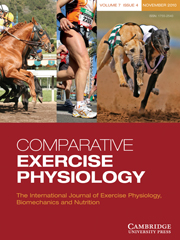Article contents
Maternal and foetal heart rates during exercise in horses
Published online by Cambridge University Press: 02 June 2009
Abstract
This study tested two hypotheses. First, that moderate exercise would alter maternal and foetal heart rate (HR) in the horse. Second, that pregnancy would alter the HR, plasma cortisol and plasma lactate response to moderate exercise in mares. Six unfit, pregnant Standardbred mares (6–19 years) underwent two incremental graded exercise tests (GXT). The first GXT was performed at approximately 9 months of gestation, which represents c. 80% of the total pregnancy time, and the second GXT at approximately 6 months post-parturition. During the GXT, mares ran on a treadmill up a fixed 6% incline completing three 1 min steps at velocities of 4, 6 and 7 m s− 1. Maternal HR was obtained via both electrocardiograph (ECG) and the ventricular waveform obtained from a micromanometer catheter. Data were recorded at rest, at 4, 6 and 7 m s− 1 of the GXT and at 0, 1, 2, 3, 4 and 5 min post-GXT. Foetal HR rate was measured via ECG before, immediately after and at 1, 2, 3, 4 and 5 min post-GXT. Radioimmunoassay (RIA) kits were used to measure plasma cortisol concentration in samples collected before the GXT, immediately after exercise and after 5 min of recovery. Plasma lactate concentrations (LA) were measured at rest, at 4, 6 and 7 m s− 1 and at 5 min post-GXT. Plasma cortisol concentrations were measured using RIA and the samples collected at rest, immediately after and at 5 min post-GXT. Exercise caused no change (P>0.05) in foetal HR. Maternal HR, plasma LA and plasma cortisol concentration were greater (P < 0.05) during the post-parturient GXT compared with the pre-parturition GXT. Body weight (mean ± SE) was lower after parturition (570 ± 20 vs. 505 ± 22 kg; P < 0.05). Consequentially, there were differences (P < 0.05) in work rate (watts) at each step of the GXT (1557 ± 53 vs. 1381 ± 60; 2339 ± 80 vs. 2071 ± 90; and 2571 ± 121 vs. 2416 ± 105 W). These data suggest that mares benefit from greater cardiovascular efficiency during pregnancy. Additionally, the lack of a change in foetal HR suggests that the unborn foal is not stressed during moderate maternal exercise.
Information
- Type
- Research Paper
- Information
- Copyright
- Copyright © Cambridge University Press 2009
References
- 2
- Cited by

